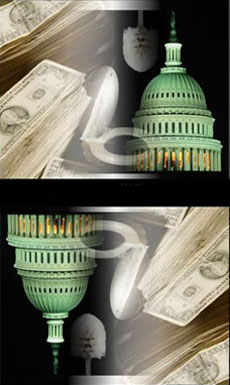|
National Election Data Archive Project Page 1 3/30/2005
US Count Votes'
National Election Data Archive Project
Response
to the Report Evaluation of Edison/Mitofsky Election System 2004
http://exit-poll.net/election-night/EvaluationJan192005.pdf
Executive Summary
by Josh Mitteldorf
The most thorough and best-established exit poll for U.S. Presidential
elections is the Edison/Mitofsky poll, commissioned by major TV networks and print news services to predict the election outcome
hours before the official count is known. In November 2004, results of the poll differed sharply from the official vote tally.
In fact, the weighted national poll predicted a Kerry victory by 3% in the popular vote, while the official count had Bush
the winner by 2.5%(1). This was the largest discrepancy in the poll’s history(2).
The
2004 discrepancy arises in a context shaped by numerous reports of voting machine problems and irregularities in the vote
count, an overwhelming majority of which favored Bush. Can exit poll results be interpreted as an indication of the global
net impact of voting irregularities and bias in the official vote count? Or is it more likely that a bias crept into the exit
polls, and this error accounts for the bulk of the discrepancy?
The Edison/Mitofsky organization argued for the latter
hypothesis and warned against the use of their polling data to discredit the official vote count. On 19 January, they released
summaries and statistical measures from their exit poll data. However, they have not released the raw data that would facilitate
independent corroboration of their analysis.
With the raw exit poll data, statisticians at E/M were in a position to
extract several measures that could help resolve the question whether the exit polls or the official count was at fault. The
19 January report includes little of this kind of analysis; instead, almost all their analysis is predicated on the assumption
that the official vote count was accurate, and seeks to find fault with the polling methodology.(3)
So
it remains for independent statisticians to ply the summary data which E/M have provided in pursuit of the question: Was it
more likely that the exit polls or the official vote count was at fault?
Our analysis of this question is based on
summary data in the 19 January E/M report itself.
- Comparisons between exit poll results and official vote tallies by state.
- Corresponding comparisons for the 32 states in which Senate races were held.
- Table of precinct discrepancies according to partisan leaning of the precinct.
- Table of precinct discrepancies according to placement of the pollster.
- Table of poll cooperation rates according to partisan leaning of the precinct.
- Table of precinct discrepancies according to type of voting equipment.
More certainty would be possible if E/M were to release the full, precinct-level data set.
1
p. 20 Evaluation of Edison/Mitofsky Election System 2004 by Edison Media Research and Mitofsky International, Jan. 19, 2005
2
p. 34 Evaluation of Edison/Mitofsky Election System 2004 by Edison Media Research and Mitofsky International, Jan. 19, 2005
3
It is appropriate that E/M should focus their analysis on the factors under their control, and pursue exhaustively the possibilities
for error in their own work. To judge the integrity of the government’s electoral apparatus was never part of their
mission, and indeed to do so could affect their reputation and jeopardize their business future as America’s pollster
of record.
Source:
bellaciao.org
|
